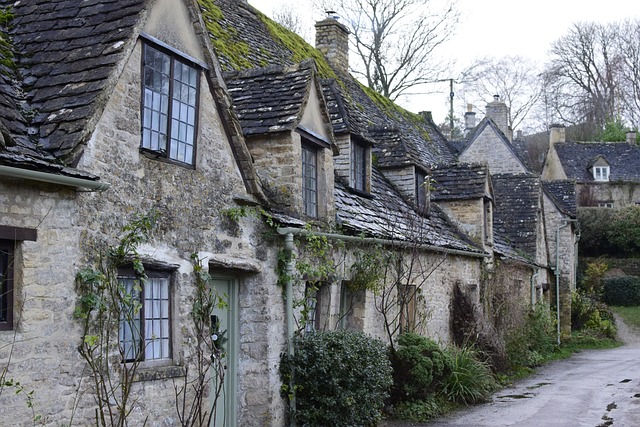7 September 2023
Listing vs Climate Change
A historic burden.
By Lynda Goetz

The heading should of course be ‘Listing and Climate Change’, but for whatever reason the authorities seem determined to ensure that the two are in conflict. If you own a listed property you must not install double-glazed windows. If you own a listed house you must not put solar panels, of any description, anywhere within the curtilage of the property. If you own a listed property you must keep it pretty much as it was in 1948 – irrespective of both the historical paradoxes and the modern-day advances in materials or improvements in technology which would make it more environmentally sound and almost certainly less expensive and more convenient to live in. Surely it is time to review some of these anachronistic rules and laws which make custodianship of historical properties an expense and a chore, rather than a joy and an honour?
I have written on this subject before (Planning Strategy in December 2022, Mortgage Lenders, Listed Buildings and EPCs in May 2021, Time to Revisit the List in December 2015), but this does not seem to be a subject which either of the main political parties have much time for. This is a shame, because as things stand ordinary people will not be able to afford to continue living in and looking after these historic properties. Of course, it is arguable that as there are only 500,000 or so of these properties and they represent such a tiny proportion of the country’s housing stock it is not worth wasting time on legislation regarding them. Legislation was updated in 1990 and revised and updated regulations put in place in 2019, but the onerous nature of owning any of these properties remains.
If you wish to understand a little more about ‘Listing’, how it came about (concern to safeguard the nation’s heritage after the destruction wreaked by World War II and the demolition which followed), and what it entails, the place to look is the website of Historic England (formerly English Heritage). There you can find a list of all the properties from Grade I listed mansions and castles to tiny listed cottages and phone boxes. You can also find the criteria by which properties were supposedly put on the list (and can still be put on the list). This does rather ignore the ‘mania’ for listing which went on in the early days and in particular in the 1970s, when owning a listed property had ‘kudos’, not to mention certain tax advantages (such as exemption from VAT on building works – removed when George Osborne was chancellor in 2012). Nowadays, there are very few advantages and a distinct number of disadvantages. Attempting to de-list a property is heavily discouraged (as of course it does rather imply someone in authority got it wrong in the first place) and the emphasis is on the fact that the final decision is made by the Secretary of State (advised by the experts at Historic England), which does make it sound like rather a ‘big deal’.
92% of listed properties are Grade II listed and almost a quarter (23.8%) of listed properties are in the South West, although quite why this should be is unclear. The Principles of Selection for Listed Buildings, issued by the Department for Culture Media and Sport in November 2018 sets out the updated rules. S16 specifies that to be listed a building must be either of ‘Architectural’ or ‘Historic’ interest. ‘To be of special architectural interest a building must be of importance in its design, decoration or craftsmanship’…..’ To be able to justify special historic interest a building must illustrate important aspects of the nation’s history and / or have closely substantiated historical associations with nationally important individuals, groups or events; and the building itself in its current form will afford a strong connection with the valued aspect of history’.
Clearly, it is important in a country like the UK to be able to preserve to some extent our architectural and historic heritage, and the damage caused to so many of our historic buildings during and after the Second World War was what led to the 1948 Act. That there should be some sort of mechanism for avoiding wanton, if even unintended, vandalism of old buildings in the name of progress is, in the words of 1066 and All That*, ‘a good thing’. What is not so good is that at a time of ever-rising costs, both of materials and labour, those who take on the care of historic homes should be so penalised.
Many are the stories of those who have taken on listed homes and found that not only are the materials they are required to use for building more expensive than those used in modern buildings, but that the skilled labour needed is also expensive and in short supply. Understandably rebuilding costs are more, so insurance costs more too. In an article in The Financial Times in 2016, James Pickford reported that one owner who purchased a listed building with the best of intentions spent double his original estimated bill on restoring it (£400,000 rather than £200,000) on top of his purchasing costs. Peter Anslow, director of The Listed Property Owners Club (LPOC) confirmed that this was pretty much par for the course, when he pointed out, ‘‘If you said the costs of listed building work were double, you wouldn’t be challenged on that.” In the same article another listed property owner, also an estate agent, commented, “People have become a lot more cautious about them in the last few years also because of the energy performance. People are a lot more conscious of their money and they don’t want to spend it on maintaining old properties.”
Seven years on and with Climate Change legislation even more advanced, this situation has not eased, but has made prospective owners even more wary. If governments are not very careful, climate change legislation which impacts the owners of historic houses is going to backfire in a serious way and mean that no-one is prepared to take on these buildings and all the red tape which goes with their ownership. It is time for government and local authorities to look at ways they can assist private owners of historic buildings, not by grants or actual financial help, but by concessions on overly prescriptive red tape and ensuring that conservation officials, often young and less experienced than homeowners’ expert advisors, are prepared to listen to sensible ways of circumventing and dealing with problems rather than being obstructive and ‘jobsworth’. It might also be helpful if local authorities were to look at their lists and be prepared to admit that not every single one of those private homes need be on there. How many really are ‘special’ and how many were put on there to satisfy an owner’s vanity? In this way, we might be able to ensure that so many of these attractive old buildings remain appealing to those who are prepared to live in them and look after them and do not become albatrosses which no-one is prepared to take on and conserve for posterity. There are no cases of owners of historic houses rebuilding them with reinforced autoclaved aerated concrete (RAAC) as far as I am aware. Local Authorities are in absolutely no position to take the moral high ground on the homes people live in when they cannot even build future-proofed schools for our children to be educated in or hospitals for our sick and injured.
*Humorous history book by W C Sellar


